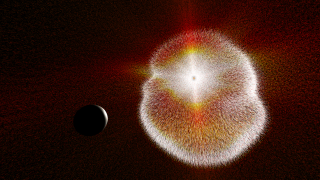A Coronal Mass Ejection strikes Venus!
We pull out from the Sun to reveal the solar wind, which continuously streams outward from the Sun.
We eventually reach the orbit of the planet Venus, the solar wind still streaming around us.
But a massive eruption, called a coronal mass ejection, or CME, takes place on the Sun, sending a much higher density of particles (ions and electrons) outward into the solar wind.
The wave of particles eventually strikes the planet Venus. But Venus has no significant magnetic field, and the particles make it directly to the atmosphere of the planet. These energetic solar events slowly blow away the atmosphere of the planet.
The next part of this sequence is "The Coronal Mass Ejection strikes the Earth!".
Technical Details
This is the dome show component moving from the Sun to Venus being hit by the CME.
The domemaster format was created by rendering 7 separate camera tiles. The tiles were then stitched together to form final domemaster layers at 4096x4096 resolution and 16 bits per channel with premultiplied alpha and no gamma correction. There are 3 domemaster layers that should be composited as follows:
- Earth and orbits
- Sun
- star field (no alpha channel)
In addition to the final domemaster frames and movies, the individual camera tiles are included as well. Each domemaster layer has a set of camera tiles. There are 7 cameras numbered 00 through 06 that represent the itiles. Camera 00 is in the center of the domemaster, camera 01 is looking below camera 00, cameras 01 through 06 look around the outside of the dome master in counter-clockwise order. These frames are probably only useful if a better re-stitching algorithm is ever required to be run on the tiles.
Related
Visualization Credits
Horace Mitchell (NASA/GSFC): Animator
Tom Bridgman (Global Science and Technology, Inc.): Animator
NASA/Goddard Space Flight Center Scientific Visualization Studio
https://svs.gsfc.nasa.gov/3867
Mission:
SDO
Data Used:
Enlil Heliospheric Model also referred to as: Enlil Heliospheric Model
Model - Community Coordinated Modeling Center (CCMC)SDO/AIA/304 Filter also referred to as: AIA 304
JOINT SCIENCE OPERATIONS CENTERThis item is part of these series:
Dome Show Planetarium
Dynamic Earth Dome Show
Keywords:
SVS >> Solar Wind
GCMD >> Earth Science >> Sun-earth Interactions
GCMD >> Earth Science >> Sun-earth Interactions >> Solar Activity >> Coronal Properties
GCMD >> Earth Science >> Sun-earth Interactions >> Solar Activity >> Solar Flares
GCMD >> Earth Science >> Sun-earth Interactions >> Solar Activity >> Solar Ultraviolet
SVS >> Space Weather
SVS >> Hyperwall
SVS >> SDO
SVS >> Solar Dynamics Observatory
SVS >> Heliophysics
SVS >> Sun-Venus Interactions
SVS >> Solar System >> Planets >> Venus
SVS >> Corona
NASA Science >> Sun
NASA Science >> Planets and Moons
GCMD >> Earth Science >> Sun-earth Interactions >> Solar Activity >> Coronal Mass Ejections
SVS >> Planetarium
SVS >> Extreme Ultraviolet Imaging
SVS >> EUV Imaging
GCMD keywords can be found on the Internet with the following citation: Olsen, L.M., G. Major, K. Shein, J. Scialdone, S. Ritz, T. Stevens, M. Morahan, A. Aleman, R. Vogel, S. Leicester, H. Weir, M. Meaux, S. Grebas, C.Solomon, M. Holland, T. Northcutt, R. A. Restrepo, R. Bilodeau, 2013. NASA/Global Change Master Directory (GCMD) Earth Science Keywords. Version 8.0.0.0.0














